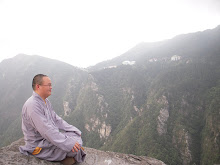
About Me
Indirectly,I am from Beijing, China. I became a Buddhist when I was young. In 2000, I decided to become a monastic at Panlongge Monastery located in Puning, Canton. And, in 2001 I was ordained as a Bikku. Afterwards, I went on to complete four years Buddhist Studies at the Buddhist Academy of China in Beijing in order to gain a clear perspective of the Buddha’s teaching. I then realized that in order to effectively combine my technical knowledge and practical skill, I need to accumulate real-world experience. Specifically, working at an overseas Buddhist Association would allow me to develop my skill and open my mind as well. Therefore, I went to the United States in 2005.
From July 2005 to the present, I have now worked for nearly three years at the Southern California Chinese Buddhist Association, which was found by Venerable Master Liaozhi in 1976. As a monastic, I am mainly responsible for our temple’s Dharma functions, and I am also supposed to deliver talks on Chinese Buddhism on Sundays, visit temple's members, and support them spiritually. This position has given me many opportunities to meet and talk with different people, Americans in particular. I enjoy it, but I also have difficulty with it, for I cannot explain Buddhism in English well.
As we can see that only by means of language can we forge the bonds of a society—a society as distinguished from some sort of instinctual swarm. In October 2007, I had a chance to work for the Chinese Buddhist Association--Hawaii. I also received finacial aid from the Southern California Chinese Buddhist Association to improve my English at University of Hawaii (UH). While working on my English language at UH, I volunteered at the Child Care Center and the Senior Day Care Center at the UH campus every Wednesday and Friday mornings from 9:00am to 11:30am for almost four months. Meanwhile, I also volunteered as a Dharma teacher at the Pure Land Association of Hawaii. I deeply appreciate the opportunities I received both at the UH campus and at the Pure Land Association of Hawaii for they have added onto my experience. Especially volunteering at the Senior Day Care Center gave me a sense that, there are large numbers of people of various ages, from all walks of life, who are suffering alone from personal tragedy, or who have been bullied or rejected in some other way by their society. They should have been comforted spiritually! As I can see that Buddhism, as one of the most peaceful religions in the world, it is a great tool that can spiritually comfort the people who are suffering the pints.
In a long term, I wish I could help to solve our society’s problems by starting my own Buddhist Studies. And I hope I can accomplish my dream someday!
ZhenGuan



